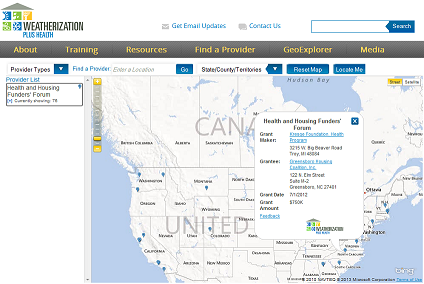This post was authored by Phillip Dodge from the Health and Housing Funders Forum.
When funders are preparing to collaborate on a specific focus area, it’s important to have a clear picture of whom and what they are already funding. This was the case at a recent meeting of the Health and Housing Funders’ Forum. Several members asked if there was an easy way to see where investments in health and housing were being made. In short, the group wanted a list of communities and locations where partners could most effectively focus their funding.
Creating a GIS map emerged as the best way to capture and detail each member’s investments in health and housing. We assembled a small group of members and set about defining specific information needed, including: grantee names, grant amounts and grant periods, and geographic dispersion of grants. The group also investigated what kind of search and display functionality would be required. Then, we developed an RFP and distributed it to a few potential contractors.
Meanwhile, at a joint meeting of the Funders’ Forum and the Federal Healthy Homes Workgroup, we learned that the U.S. Department of Energy was already funding the National Association for State Community Service Programs (NASCSP) to develop just such a map and that it would already include all grants made by the U.S. Department of Housing and Urban Development’s Office of Healthy Homes and Lead Hazard Control.
The Funders’ Forum’s first round of grant data is now available on the NASCSP map, which is live on the Weatherization Plus Health Find-a-Provider website. The map contains grant data from the Pew Charitable Trusts, the Kresge Foundation, and the St. Luke’s Foundation.
The data is updated on a monthly basis and we will be adding grant data from additional Funders’ Forum members in the coming weeks. We welcome grant data from any foundations working in the areas of environmental health.
The greater number of foundations represented on the map, the more detailed our picture of investments will be. For example, the U.S. Department of Housing and Urban Development has been a pioneer in the healthy housing movement. By overlaying foundation and federal grant information, we have a more complete picture of the funding landscape.
While the purpose of the map was to show where investments are being made, it’s equally helpful to see where they are not. As more members upload their grant data, we will gain a better understanding of where members can collaborate and pockets of the country from which we need to recruit new members. Ideally, the map will be used to increase collaboration among foundations and with the Federal Government. Regionally-focused funders can use the map to explore grants in their communities made by other foundations and federal agencies. And ideally, national funders and federal agencies can use it to see regions that are ripe for collaborative activities and regions that need greater investment.
The map is a work in progress and can be an incredible resource for fostering collaboration and increasing investments in healthy housing and healthy communities. Collecting grant data has been more difficult than we anticipated, but we are reaching our tipping point and hope to have a more robust data set in the coming weeks and months. And of course, we welcome HEFN members to add to this dataset.
The Funders’ Forum is a non-dues paying collaborative, which provides its members with a range of opportunities, tools, and resources, including for example, webinars, peer networking, and conferences. To learn more about the Funders’ Forum, please call or e-mail Phillip Dodge at 443-539-4168.
Phillip Dodge from the Health and Housing Funders’ Forum authored this post. The Health and Housing Funders’ Forum was founded by the Kresge Foundation in 2009 to align philanthropic funding plans and priorities in the housing and health space. It fosters collaboration among philanthropic organizations to make a significant impact in the area of healthy housing and healthy communities.

